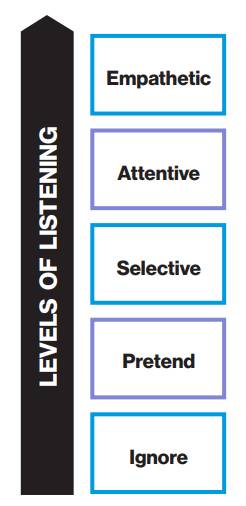Confirm an Effective Solution
Learning Objectives
After completing this unit, you’ll be able to:
- Explain the importance of listening empathetically.
- Apply Dale Carnegie’s listening principles.
- Respond to objections in relationship selling.
Listen Empathetically
Objections can be frustrating. How do you handle them? In this unit, you focus on the Dale Carnegie principle: “Show respect for the other person’s opinion. Never say, ‘You’re wrong.’” Sometimes the hardest part of resolving objections is truly listening to the customer empathetically.
In this unit, you take a closer look at the Confirm phase of the sales model and how it relates to empathetic listening and handling objections.
In Dale Carnegie’s global study of 1,000 consumers, 87% of respondents said the salesperson’s listening skills were very or extremely important to a strong relationship. You can read more in the Trust Is Dead whitepaper.
Deepen Your Relationship by Listening
Listening shows you’re sincere and trustworthy. It shows that you want to solve a problem, not just offer your solution to anyone who will listen. It builds relationships. So, do more listening than talking. Show that you want to build a relationship, not just make another sale.
Here are Dale Carnegie's principles to help you listen effectively.
- Maintain eye contact with the person talking.
- Be sensitive to what is not being said. Observe body language for incongruent messages.
- Practice patience. Do not interrupt, finish the speaker’s sentence, or change the subject.
- Listen empathetically and listen to understand. Act as if there will be a quiz at the end.
- Clarify any uncertainties after the person has spoken. Make sure you understand what was said by rephrasing what you heard.
- Don’t jump to conclusions or make assumptions. Keep an open and accepting attitude.
- Practice empathetic listening. Remove all distractions.
- Turn off your mind and “be with” the speaker. Try to see things from their perspective.

Empathetic listening also involves listening with your eyes. Be attentive to buying and warning signals. Watch for sudden changes in body language, facial expression, and vocal inflection. Be prepared to advance or step back depending on what you observe. These signals are discussed in detail in the Winning with Relationship Selling course.
Understand the Nature of Objections
In transactional selling approaches, salespeople expect objections to arise. They handle overcoming objections as an “intervention,” or a sales trick to memorize and master, like the Feel, Felt, Found Objection Handling technique. Customers rarely fall for these tricks. Many objections can be prevented by following the Relationship Selling model.
Objections arise in a different way using relationship selling than when transactional techniques are used. In transactional selling, price is the most common objection. There is usually no way to overcome this objection because transactional selling forces a price focus.
In relationship selling, price is only one factor. The emphasis is on the overall value of what you offer, including the value you bring as a salesperson and partner.
Respond to Objections
Dale Carnegie offers several tactics to address objections and an example of how to apply them below.
| Tactic | Description |
|---|---|
|
Cushion |
A response that shows you listened to the concern and recognize its importance. It does not agree, disagree, or answer the objection. It acknowledges the emotion that was conveyed. |
|
Clarify |
Ask a nonthreatening question to clarify the objection. |
|
Cross-Check |
Confirm that the specific hesitation is the only factor preventing the commitment. |
|
Reply |
Deny, admit, or reverse the hesitation. Provide an explanation.
|
|
Trial Commitment |
Ask a question to determine if the objection has been resolved. |
Objection example: “My team is happy with the process they’re currently using.”
- Cushion:”We hear that from time to time.”
- Clarify: “How do you think learning a new process would benefit them... (major benefit)?”
- Cross-Check: “In addition to this concern, is there anything else causing you to hesitate?”
- Reply: “Your concern about your team being uncomfortable with a new process may be the very reason you should consider moving forward. (Evidence) Let me provide an example of another client who had similar concerns…”
- Trial Commitment: “How do you think your team would respond if a similar outcome were possible for them?”
Evidence is key to removing doubt. The benefit of being prepared with evidence is that you can overcome hesitation with confidence. Responding to objections in this manner demonstrates respect for the potential customer. This helps to build the relationship.
Try It for Yourself
In the Resource section, we’ve provided you with the Respond to Objection Worksheet. Think of some common objections you commonly come across. Use this worksheet to help overcome hesitation and build on your relationship with the customer.
In the next unit, you learn how confirming the solution leads to commitment.